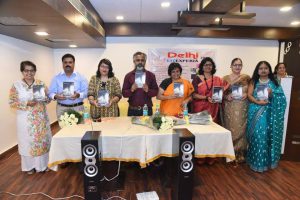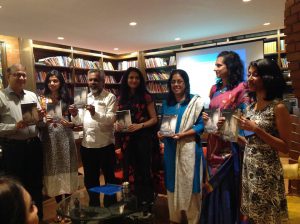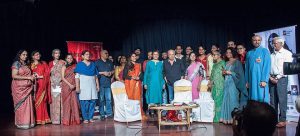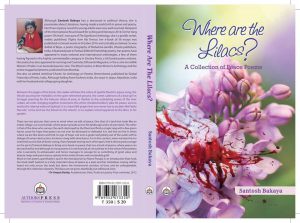Interviewing the Master-minds Behind Silhouette I & II And Other Fiction
Silhouette I & II And Other Fiction published by Authorspress, edited by Reena Prasad, Michele Baron and Dr. AV Koshy, is one of its own kind of an anthology in the arena of contemporary Indian writing in English. The anthology features the International Reuel prize winning novella ‘Eternal Links’ by Sunila Kamal, ‘The Silhouette’ by Dr. Santosh Bakaya of ‘Ballad of Bapu’ fame, and ‘The Silhouette Sequel’ by Dr. AV Koshy (co-editor), which explains the title of the anthology. The book also consists of a variegated assortment of short stories penned by established and upcoming authors who all happen to be the members of the Facebook literary group ‘The Significant League’. I am also one of the contributors of this anthology. 
Dr. Santosh Bakaya in the introduction to the book, refers to Neil Gaiman’s words: ”Short stories are tiny windows into other worlds and other minds and other dreams. They are journeys you can make to the far side of the universe and still be back for dinner.” Each of these stories in the collection solidify this quote. There has never been a dull moment while reading it yet. Each story comes with its own journey, its own ascending and descending points, its own rising and climax.
The interview below is with two of the anthology’s three editors, Dr. AV Koshy and Michele Baron.
Lopa Banerjee: Hello Dr. Koshy, Michele Baron, can you tell me a bit of the background of this compilation of stories, and how this book came into being?
Dr. AV Koshy: We ran a NANOWRIMO in our group and Michele chose Sunila’s as the best story. That was the beginning. As we got other Reuel Prize winners like Santosh Bakaya and Pramila Khadun published earlier, both Reena and myself wanted to get her published too. Around the same time Santosh wrote Silhoutte and I felt like writing its sequel and as a result we suddenly had three things we wanted to publish. We felt that was not enough, so we put out a call in our groups and the anthology, not defined with any specific theme, got terrific responses. We put it together and hey presto! We had one more after THE SIGNIFICANT ANTHOLOGY. Sudarshan Kcherry came forward to publish it and we were so grateful to him for the same, so that was how Silhouette I and II and other short fiction came into being. As usual, we tried our best not to compromise on quality.
Michele Baron: Many of us, emerging and established authors, readers, and experimenters-of-form, came together in a global Facebook group called The Significant League (named after our pilot offering, ‘The Significant Anthology’, published in 2015). ‘Silhouette I & II’ contains novelettes written during the NANOWRIMO challenge 2016. There is always a lot of energy, a plenitude of inspiration in a young literary group. Our authors were eager to write, full of wonder about what might be possible. Title stories composed by Dr. Santosh Bakaya and Dr. Ampat Koshy form the glue binding this hybrid collection of short fiction, and the editors worked diligently to preserve the authenticity of each contributor’s voice, ensuring a co-creation of works that embraces the many different traditions, aspirations, and world-views of the participating writers.
Lopa Banerjee: What inspired you as editors to choose the title of the anthology as ‘Silhouette I&II’? Can you tell the readers a few words about the concept behind the book’s cover illustration, i.e., the silhouette of a man standing on the rocks by the ocean? What does that image signify in terms of the subject-matter/theme of the anthology?
Dr. AV Koshy: I will let Michele talk on the powerful cover as she did it mainly but I took Gauri Dixit’s photo of Kovalam which looked beautiful as a backdrop and the final touches were done by Authorspress who always does scintillating covers. He superimposed Michele’s painting on to the beach and rocks for the back. This one was no exception.
Michele Baron: The anthology’s title is inspired by the short stories written by Dr. Santosh Bakaya, and Dr. Ampat Koshy. Other works are written on themes chosen by the respective authors. Actually, I painted the image on the cover of Silhouette I & II, although the publisher re-formatted the title/author-info I’d originally written upon it. The image is of a long-coated figure, which might be a man, but the hat and looseness of the coat obscure the gender, age, and even the aspect (coming or going) of the silhouette. The foreground, as well as the background is mottled and shrouded with fog, and was meant to resemble the changing tides of fortune, the uneven, unpredictable landscapes of the journeys each of us must take through life.
The light emerges from an undisclosed source, and might be the headlights of a vehicle passing by, or other ray of illumination breaking through the darkness of uncertainty—at once providing visibility, and spotlighting just how intangible the moment of waiting, before immersion in each story of the anthology, each adventure of our own lives, can be.
The silhouetted EveryPerson of the cover art might be an ‘Other’, ourselves, or “our hero” — who enables us to safely view life’s various challenges and mysteries through the lenses of each author in the collected volume.
The back cover image of the rocks along the ocean at Kovalam was supplied by another of our authors, Gauri Dixit; the rugged beauty of the coastline speaks for itself.
Lopa Banerjee: How do you think this anthology can make a difference in the contemporary market of fiction anthologies?

Delhi Litexperia–book launch
Dr. AV Koshy: See, Lopa, frankly today’s world is disappointing as they seem to look for brand names in publishing and already famous names to decide who is good and who is not. This anthology was read by many whom I knew and whom I did not– each person said it is remarkable, it is easily a 4.5 or a 5. But it goes no further. However, we scored a great success when Sudarshan Kcherry sent his catalogue to Library of Congress USA with no recommendations of books published in 2017 and backwards and this was bought by the Library of Congress. I hope it shows someone somewhere has/had the brains to realize just how good it is. Hopefully in libraries they send it to in eight or so countries or where it will be listed in the books, so that someone picks it up, and then it will go further. Truth is, unless academics write of us, no one cares if we don’t get awards or are published by big names or are not available in bookstores.
Michele Baron: Our contributors hail from all across the globe, and offer voices ranging from the newly-fledged, as well as highly seasoned and published. Not all of us, as authors, have been encouraged to sing loudly, but in Silhouette I & II, all our contributors face the dragons and uncharted territories of their fiction, and map the journeys for us, in songs and anthems, stories and poems clearly articulated. Such a compendium of international voices, and the tales they tell, is special, and well deserves its place on the marketing shelves of contemporary fiction anthologies.
Lopa Banerjee: Your thoughts about the Reuel Fiction Prize winning novella by Sunila Khemchandani Kamal, ‘Eternal Links’? Why did you choose to feature this novella in ‘Silhouette I & II And Other Fiction’, along with the other stories featured in the anthology? What would you say about the novella in terms of theme, characterization and style of narration, with your editors’ lens?
Dr. AV Koshy: We try to get Reuel Prize winners and our admins in TSL and others there published and promoted in our own way. This was our prize or gift to her. Instead of money a publication is better, don’t you think, of course due to Sudarshan’s kindness.
Michele Baron: In so many cases, it is difficult to choose from among the panoply of so many authors, so many thoughts, and styles, and stories. The poet William Carlos Williams wrote several famous maxims which may illuminate the mystery of writing, and the vagaries of choice:
“Forget all rules, forget all restrictions—as to what ought to be said.. Write for the pleasure of it… No ideas but in things… Invent!” [W.C.Williams’ poem “A Sort of a Song”].
The novella written by 2016 Reuel Prize Winner Sunila Khemchandani Kamal stood out among the entries presented for consideration for Silhouette I & II, but the anthology as a whole is a very strong collection of voices, speaking from experience and imagination, concocted of local idiolect, dialogue, imagery, and invention. It was indeed a challenge to choose from among the great variety of engrossing offerings, and a joy to include so many authors in the anthology itself.
Lopa Banerjee: Dr. Koshy, what prompted you to write the ‘The Silhouette Sequel’, taking the cues from Dr. Santosh Bakaya’s dark, sinister thriller ‘The Silhouette’? Do you think such cerebral and creative collaborations in short story writing will go a long way in promoting the real essence of literature? I am asking this question since I have seen that currently the trend is to write more market-oriented novels in the thriller genre, with less literary flair and more glossy storytelling with fast-paced narration? What is your take on such fiction?
Dr. AV Koshy: Silhouette Sequel is cerebral, it is also fast paced even for those who don’t get the allusions, but it is meant for a niche audience. As for the collaboration, Santosh’s lovely story really inspired me– that is why I took it on. The trend is always to write what is more popular and we fight against it as we are naturally trying to write at a higher level, nothing can be done about it. Popular fiction has its place as people do want light reads but no reason why we should compromise and be less demanding in our writing of our readers and not stretch them as I have done in my story in their capabilities.
Lopa Banerjee: If I give you the choice to pick and choose the most poignant and remarkable stories in the collection apart from the title story ‘Silhouette’ by Dr. Santosh Bakaya, which stories will come to your mind?
Dr. AV Koshy: Well, this may be biased but Joanna Koshy’s story stands out for me as does the stories of Angela Gamos, Dominic Francis and so many others including Reena’s snake story. The question is a bit unfair actually as the truth is, we got only good stories and all matter, though some may matter more to some and some to the others. A reader of mine loved your story Lopa. I loved Aiswarya’s too and Daipayan’s and Gorakhnath’s and, well, as editors we liked all, or we would not have taken all. Michele’s is very fine writing.
Michele Baron: Our authors provided much inspiration to the editors, from stark stories of survival to fanciful presentations of alternate realities. “Dreams and Reality” (Rhiti Bose), “Destiny Meets Me” (Anindita Bose), and “Beauty Revised” (Soumya Mukherjee) combine with “Survival of a Stripper (Angela F20cc), “A Bottle of Vinegar” (Fatima Afshan), and “Moon River Debris” (Vineetha Mekkoth) with flair and promise — a promise further extended and expended by all the participating authors of Silhouette I & II.

Bangalore launch of the book in Atta galatta bookstore
Lopa Banerjee: What has been the publishing journey of this anthology with Authorspress, one of the scholarly and literary publishers based in India? Authorspress in the recent few years has been quite known to publish literary works in India which are sometimes avant-garde, experimental and out of the mainstream in terms of their subject matter and writing. Who would be your readers of this anthology of selected fiction, now that the book has found a home in the Library of Congress, USA? The usual fiction readers in India and USA, or the more discerning readers who understand and appreciate quality literature?
Dr. AV Koshy: Absolutely, without Authorspress we would be nowhere or nothing. I hope we find quality and appreciative and discerning readers but nowadays it is tough with an anthology coming out every day literally. I do want to thank the publisher for arranging a beautiful launch for us in Delhi, especially, apart from bringing this book out in such a fine manner.
Michele Baron: I defer to my co-editors, who have greater tenure, training, and accomplishment as scholars, educators, critics, and authors of writing.
Lopa Banerjee: Short stories written since the times of classic English fiction writers like O. Henry, Guy De Maupassant, Earnest Hemingway and Teo Tolstoy have been the celebration of the tiny windows in the lives of their protagonists which have been delectable for their engaging narratives in spite of the precision in their scope of storytelling. In the Indian subcontinent, authors like Premchand, Rabindranath Tagore and others have excelled in this art of storytelling, as did some Indian authors in English including R.K. Narayanan, Mulk Raj Anand, Vikram Seth, Jhumpa Lahiri (diaspora category) and not to forget, Khushwant Singh. Do you think some contemporary fiction writers have the same sharp literary attributes, though they may not be as renowned as them, presently?
Dr. AV Koshy: Definitely, Lopa, but no one will believe it till we get awards and are written of in critical studies which is how we enter the mainstream and also till we are found in book stores and appear on syllabuses – we just need more validation.
Michele Baron: People find their points of reference not only in looking to the past, nor, alone, in standing upon the shoulders of the greats, to gaze into the still-nebulous future. I think contemporary readers, and readers of the future, might, indeed, discover that some of the short fiction written in these times, some among the contemporary “college” of authors, do possess the acuity and appeal of the “timeless” authors who have preceded us.
Lopa Banerjee: As founder and admins of the Facebook literary group, The Significant League, you have instituted the International Reuel Prize in poetry, fiction and translation and also literary criticism which is in its fourth year in 2017. Can you tell me a few words about the significant milestones achieved in these four years as a part of this literary group and what is your vision for the International Reuel Prize and its awardees in the coming days?
Dr. AV Koshy: We are building step by step and stone by stone but the awardees have done well. Very well. All of them have carved a niche for themselves now, and how they leverage it in the near future is up to them. The milestones are introducing it for poetry, expanding it to other genres, and keeping its special thrust for differently abled people also alive. It is an activist prize. We try to be impartial and fair and give new comers a chance and I don’t really see others doing that as much in my opinion.
Lopa Banerjee: Finally, what would be your message to the aspiring south-Asian writers trying to break in the contemporary literary marketplace?
Dr. AV Koshy: Get proper contracts, get into bookstores, use science fiction literary agents if need be, get awards, be on it all the time but don’t forget that ultimately the content and style and form of your language is what matters.
Michele Baron: We are an internationally-educated, internationally-located writing group, and yet we form a neighborhood, small enough that we recognize names, become familiar with the styles, and begin to be somewhat jocular in our online commentary and support of our fellow authors. We do have contributors in other tongues and alphabets, but the language of our publications remains English and its jargon and vernaculars.
It is interesting to be something of a migrant among people (as I seem to be). Market demographics target specific groups, and attach labels and priorities which writers, themselves, might not discern as relevant during the process of inspiration, creation and publication. As humans, we experience hopes, fears, disasters, and dreams. Some of our journey is informed by our origins, race, religion, education, and access; some of it is general to all of humanity. As far as my message to the aspiring south-Asian writers trying to emerge in the contemporary literary marketplace (or to survive the slings, arrows, and edits of time, and be “discovered” in some distant future) is concerned, I would say, to any, as to each, be true to your experience and capacity to conceive, and create, a coherent piece of writing. There is plenty of ‘formula’ writing available, and I suppose it is profitable to those in the ‘formula’ slip-stream, but the vitality and veracity of the art, for me, is in the purity of the need to give voice to thoughts and experience. Whether through written word, spoken word, music, visual arts, or other performance arts, the light of truth which can unite heart, mind, and the intangibles of being are what I find most inspiring, and most necessary to writing.
This probably makes me an anomaly, something of an outsider to the “marketplace” of writers, of writing. It would be lovely to be successful. People do strive for excellence, thirst for recognition, after all. That an internationally-authored anthology of writing, such as Silhouette I & II, has emerged from indie ranks to its seat on the shelves of readers in private homes, and included among the many noteworthy works in the US Library of Congress archives is a wonderful thing — to writers of south-Asian origins, or of, any, all, nationalities.
I would also add to this, write, listen, and write some more. Find your voice, and present it, and your stories, to the world. With thanks to anthologies such as Silhouette I & II, the world will have its chance to discover, and read, your writing. The future will proceed from there, if you keep writing.
Bios:
Dr. AV Koshy is an Assistant Professor at the Department of English at the College for Arts and Humanities for Girls, Jazan University, Kingdom of Saudi Arabia, a widely published poet and Pushcart-nominee, literary critic, fiction writer, editor and anthologist. He has won many prizes and holds many positions and awards as a writer. He is the founder of The Significant League, a vibrant literary group in Facebook, has instituted the Reuel International Literary Prize in 2014 and runs an autism NPO with his wife Anna Gabriel.
Michele Baron is a world traveler, former Fulbright Fellow who currently lives in Kyrgyzstan. She develops outreach projects, writes poetry, prose, nonfiction, has self-published A Modest Menu: Poverty, Hunger and Food Security, in Poetry and Prose; and A Holiday Carol, and blue wings unfolding at Amazon.com; and is a visual/performance artist, among other occupations.
Lopa Banerjee is an author, poet and translator, a Journey Awards winner of Chanticleer Reviews 2014 and Honorable Mention awardee at the Los Angeles Book Festival 2017. She is currently based in Dallas, TX.


 y last year that was inaugurated by Shyam Benegal, and it was a huge success. It managed to enliven back Smita Patil into our lives and showcased her as a classic actress to the newer generation who had only heard about her. What made the festival different though was the conversations that made people reflect and think deeper, and of course left a lingering taste and memory long after it was over, much to their liking!
y last year that was inaugurated by Shyam Benegal, and it was a huge success. It managed to enliven back Smita Patil into our lives and showcased her as a classic actress to the newer generation who had only heard about her. What made the festival different though was the conversations that made people reflect and think deeper, and of course left a lingering taste and memory long after it was over, much to their liking!










